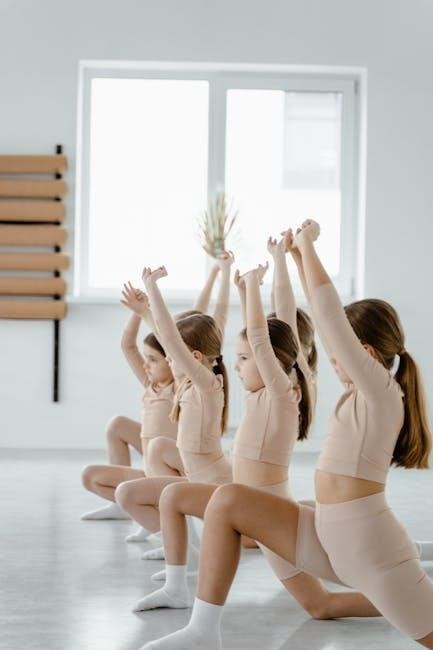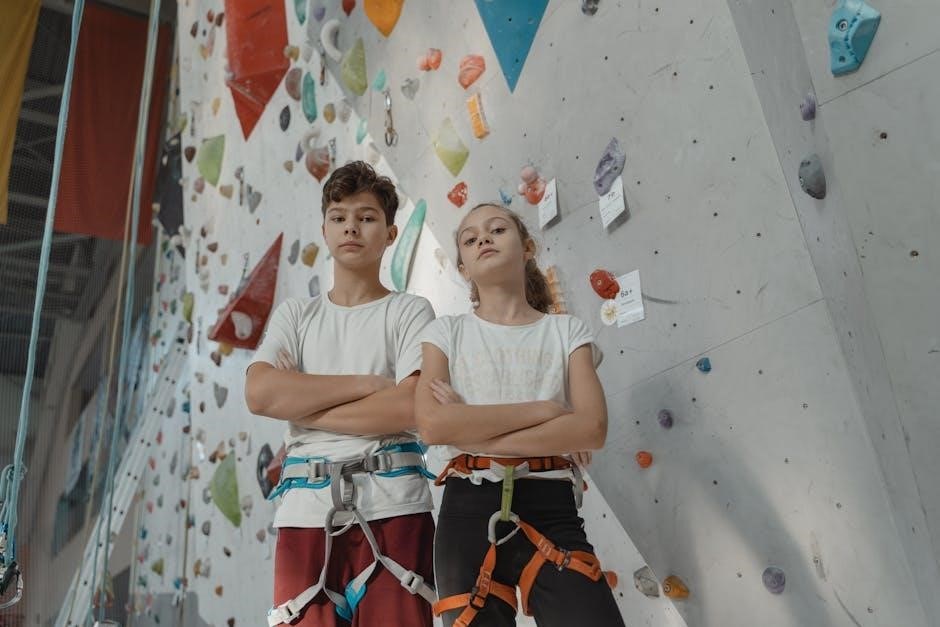Ataxia is a neurological condition affecting coordination, balance, and speech, impacting motor skills and daily activities. Coordination exercises are essential for managing symptoms, improving motor control, and enhancing quality of life.
1.1 Definition of Ataxia and Its Impact on Motor Skills
Ataxia is a neurological disorder characterized by impaired coordination, balance, and speech. It affects motor skills, causing difficulty in voluntary movements, such as walking, writing, and eye movements. Cerebellar ataxia disrupts coordination, while sensory ataxia results from impaired proprioception. This condition often leads to clumsy or unsteady movements, making everyday tasks challenging. Understanding its definition is crucial for developing targeted exercises to address its impact on motor function and overall mobility.
1.2 Importance of Coordination Exercises in Managing Ataxia
Coordination exercises are vital for managing ataxia, as they improve motor control, balance, and overall mobility. These exercises target specific areas such as upper and lower limb coordination, gait training, and proprioception. Regular practice can slow disease progression, enhance functional abilities, and boost independence. Tailored routines, including home-based programs, are essential for long-term benefits, making coordination exercises a cornerstone of ataxia rehabilitation strategies.
General Principles of Coordination Exercises for Ataxia
Coordination exercises for ataxia focus on repetition, sensory cues, and gradual progression. Activities are simplified and performed slowly, emphasizing quality of movement over speed to improve motor control.
2.1 Repetition and Consistency in Motor Activities
Repetition and consistency are key principles in coordination exercises for ataxia. Regular practice of specific motor tasks helps reinforce neural pathways, improving muscle memory and movement accuracy. Patients are encouraged to perform exercises daily, focusing on controlled, precise movements. Over time, consistent repetition enhances coordination and reduces ataxic symptoms, such as unsteady gait and limb tremors, leading to better functional outcomes and independence in daily activities.
2.2 Use of Sensory Cues for Enhanced Motor Performance
Sensory cues, such as tactile, visual, and proprioceptive inputs, play a crucial role in enhancing motor performance for individuals with ataxia. These cues help guide movements, improve coordination, and provide feedback. For example, visual cues like mirrors allow patients to observe their movements, while tactile cues involve physical guidance to correct posture or alignment. Proprioceptive exercises, like heel-to-toe walking, enhance body awareness. Consistent use of these cues helps patients develop better motor control and reduces ataxic symptoms over time.
2.3 Progression of Exercise Difficulty and Speed
Exercises for ataxia should progress gradually in difficulty and speed to avoid overwhelming the patient. Initially, slow and simple movements are introduced to build foundational motor skills. As coordination improves, tasks are made more complex, such as increasing the speed of limb movements or adding dual-task activities. This progression ensures continuous challenge without causing frustration, promoting steady improvement in motor control and overall functional ability.

Specific Coordination Exercises for Ataxia
Exercises target upper and lower limbs, balance, and gait. Activities include marching, shoulder pendulums, and balance training to enhance motor control and reduce ataxia symptoms effectively.
3.1 Upper Limb Coordination Exercises
Upper limb exercises focus on improving hand-eye coordination and fine motor skills. Activities include arm extensions, finger tapping, and reaching tasks. These exercises help reduce tremors and enhance dexterity, making daily tasks easier. Consistency and repetition are key to rebuilding motor control and confidence in patients with ataxia. Over time, these exercises can significantly improve functional abilities and overall quality of life.
3.2 Lower Limb Coordination Exercises
Lower limb exercises aim to improve gait, balance, and leg coordination. Activities include marching in place, heel-to-toe walking, and single-leg stands. These exercises strengthen muscles, enhance proprioception, and reduce the risk of falls. Consistent practice helps patients with ataxia achieve better stability and mobility, making walking and standing more controlled and confident. Progression to more complex movements, like side steps or balance shifts, further advances coordination and overall lower limb function.
3.3 Balance and Gait Coordination Exercises
Balance and gait exercises focus on improving stability and walking patterns. Activities include standing with eyes closed, tandem walking, and gait training. These exercises enhance proprioception and reduce ataxic gait characteristics, such as wide-based walking. Regular practice helps patients achieve smoother, more coordinated movements, reducing the risk of falls and improving independence. Tailored exercises, like heel-to-toe walking and balance shifts, are essential for advancing gait coordination and overall mobility in individuals with ataxia.
Frenkel’s Exercises for Ataxia

Frenkel’s exercises focus on improving coordination and proprioception, particularly addressing gait disturbances in ataxia. These exercises emphasize slow, controlled movements to enhance motor control and stability.
4.1 Overview of Frenkel’s Coordination and Proprioception Exercises
Frenkel’s exercises, developed by Heinrich Frenkel, are tailored for individuals with ataxia, focusing on improving coordination, balance, and gait. These exercises emphasize slow, controlled movements, often using sensory cues like visual or tactile feedback. They aim to enhance proprioception, or the body’s awareness of its position and movement. Key activities include standing, walking, and sitting exercises, designed to improve motor control and reduce instability. The program is progressive, with tasks adjusted to individual ability, prioritizing quality of movement over speed to foster functional independence and confidence. These exercises are particularly effective for addressing gait disturbances and enhancing overall coordination in ataxia patients, making them a cornerstone of rehabilitation programs focused on restoring mobility and reducing the risk of falls. By breaking down complex movements into manageable components, Frenkel’s approach helps patients rebuild motor skills systematically, promoting long-term improvement in coordination and balance. This method is widely recognized for its effectiveness in neurorehabilitation settings and is often recommended as part of a comprehensive treatment plan for ataxia.
4.2 Application of Frenkel’s Exercises in Ataxia Rehabilitation
Frenkel’s exercises are integral to ataxia rehabilitation, offering a structured approach to improve gait, balance, and coordination. They are particularly effective for addressing cerebellar ataxia, where gait disturbances are prominent. The exercises are applied in clinical and home settings, with physical therapists guiding patients through tailored routines. Progression is gradual, starting with simple movements and advancing to more complex tasks. The focus is on enhancing proprioception and motor control, reducing dependence on assistive devices. Regular practice fosters functional independence, improving walking patterns and reducing the risk of falls. These exercises are adaptable to individual needs, ensuring personalized rehabilitation plans that maximize recovery potential. By addressing both physical and functional aspects of ataxia, Frenkel’s method supports long-term motor recovery and enhances patients’ overall quality of life, making it a cornerstone of ataxia rehabilitation programs worldwide.
Modifying Exercises for Individual Needs
Exercises are tailored to individual abilities, with gradual progression based on patient response and motor skill improvements, ensuring personalized and effective rehabilitation strategies for ataxia.
5.1 Assessing Patient Ability and Response
Assessing patient ability involves evaluating motor skills, balance, and coordination through standardized tests. Responses are monitored to adapt exercises, ensuring they align with individual progress and needs effectively.

5.2 Gradual Progression and Adjustments
Exercises are progressed gradually, with small, incremental changes to challenge patients appropriately. Adjustments are made based on individual improvement, focusing on movement quality over speed. Activities are modified to maintain engagement and effectiveness, ensuring they remain achievable while promoting progress. This adaptive approach helps build confidence and motor skills, with exercises tailored to each patient’s evolving abilities and responses.

Role of Physical Therapy in Ataxia Rehabilitation

Physical therapy plays a crucial role in ataxia rehabilitation by improving coordination and balance through targeted exercises and evidence-based interventions, enhancing motor skills and mobility.
6.1 Physical Therapy Interventions for Coordination and Balance
Physical therapy interventions focus on improving coordination and balance through tailored exercises, sensory integration techniques, and progressive motor challenges. Techniques include repetition of specific movements, use of sensory cues, and gradual difficulty progression. These interventions aim to enhance motor control, reduce ataxia symptoms, and promote functional independence. Evidence-based practices emphasize slow, precise movements to improve quality of motion. Customized programs address individual needs, ensuring safe and effective rehabilitation outcomes for patients with ataxia.
6.2 Evidence-Based Practices in Ataxia Rehabilitation
Evidence-based practices in ataxia rehabilitation emphasize structured, research-supported interventions. Studies demonstrate that home balance programs and Frenkel’s exercises improve coordination and gait. Keller and Bastian’s research highlights the effectiveness of targeted exercises in enhancing walking abilities. Progression of exercises, sensory cue utilization, and gradual intensity increases are widely recommended. These practices are backed by clinical trials and patient outcomes, ensuring safe and effective rehabilitation strategies for individuals with ataxia.

Home Exercise Programs for Ataxia
Home programs are tailored to individual needs, promoting consistency and independence. They include exercises like marching in place and seated reaching, done 5-10 minutes, 5 times daily, improving coordination and balance while allowing gradual progression based on ability.
7.1 Benefits of Home-Based Coordination Exercises
Home-based exercises offer convenience, flexibility, and consistency, enabling patients to practice regularly. They enhance motor skills, balance, and daily functioning without requiring specialized equipment, fostering independence and confidence. Regular practice improves coordination, reducing ataxia symptoms and promoting better mobility. Additionally, home exercises allow for personalized progression, ensuring activities remain challenging yet achievable, leading to sustained improvement in overall motor control and quality of life.
7.2 Sample Home Exercise Routine for Ataxia

A typical routine includes seated marching, arm circles, and single-leg stands. Marching enhances lower limb coordination, while arm circles improve upper limb control. Single-leg stands boost balance. Perform each exercise 5-10 times, 2-3 times daily. Progress by increasing duration or difficulty, ensuring movements are slow and precise. Focus on quality over speed to maximize benefits for coordination and stability, promoting overall functional improvement in managing ataxia symptoms effectively.
Measuring Progress and Outcomes
Progress in coordination and balance is assessed using standardized tools like the Scale for the Assessment and Rating of Ataxia (SARA). Regular evaluations track improvements in motor skills, gait, and overall functional abilities, ensuring exercises are tailored to individual needs and outcomes.
8.1 Assessment Tools for Coordination and Balance
Standardized tools like the Scale for the Assessment and Rating of Ataxia (SARA) and the Berg Balance Scale are used to evaluate coordination and balance in ataxia patients. These assessments measure gait, stance, and limb coordination, providing objective data on motor function. They help track progress, identify areas needing improvement, and ensure exercises are effectively tailored to individual needs, promoting targeted rehabilitation strategies.
8.2 Tracking Improvement in Motor Skills
Regular assessments and objective measures, such as gait analysis and coordination tests, help track improvements in motor skills. Patient feedback and observable changes in movement quality are also crucial. Progress is documented to refine exercise plans, ensuring they remain challenging yet achievable. Over time, consistent practice leads to noticeable enhancements in balance, coordination, and overall functional abilities, supporting long-term recovery and independence for individuals with ataxia.

Additional Resources and References
Recommended studies and exercise guides are available online, including Frenkel’s coordination exercises and home programs for ataxia. Access detailed PDF resources for comprehensive practice routines and research findings.
9.1 Recommended Literature and Studies on Ataxia

Keller and Bastian’s study on home balance programs for cerebellar ataxia highlights significant improvements in walking abilities. Frenkel’s coordination exercises, originally for tabetic ataxia, remain relevant. Works by Levin and Cohen explore motor control and coordination strategies. These resources provide evidence-based approaches for managing ataxia through targeted exercises. Accessing these studies in PDF format offers practical insights and detailed exercise routines for both patients and therapists, ensuring informed and effective rehabilitation practices.
9.2 Accessing Coordination Exercises for Ataxia in PDF Format
PDF resources on coordination exercises for ataxia are widely available, offering detailed routines and research-backed approaches. Studies by Keller, Frenkel, and Levin provide comprehensive guides for improving motor skills. These documents often include step-by-step instructions, diagrams, and progress tracking tools. Accessing these PDFs through academic databases, medical websites, or rehabilitation centers ensures patients and therapists can implement effective exercise programs tailored to individual needs, promoting better coordination and balance management.

Be First to Comment